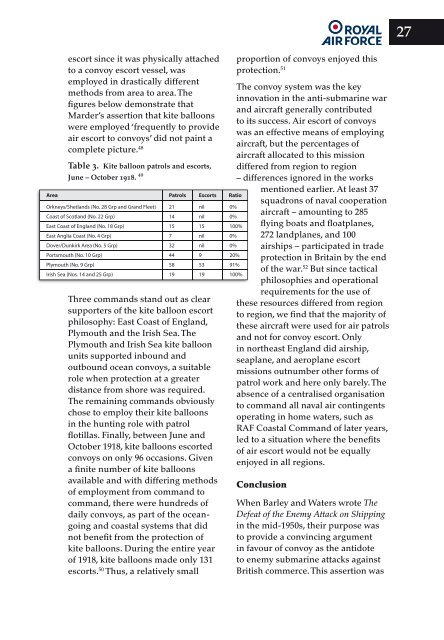Create successful ePaper yourself
Turn your PDF publications into a flip-book with our unique Google optimized e-Paper software.
escort since it was physically attached<br />
to a convoy escort vessel, was<br />
employed in drastically different<br />
methods from area to area. The<br />
fi gures below demonstrate that<br />
Marder’s assertion that kite balloons<br />
were employed ‘frequently to provide<br />
air escort to convoys’ did not paint a<br />
complete picture. 48<br />
Table 3. Kite balloon patrols and escorts,<br />
June – October 1918. 49<br />
Three commands stand out as clear<br />
supporters of the kite balloon escort<br />
philosophy: East Coast of England,<br />
Plymouth and the Irish Sea. The<br />
Plymouth and Irish Sea kite balloon<br />
units supported inbound and<br />
outbound ocean convoys, a suitable<br />
role when protection at a greater<br />
distance from shore was required.<br />
The remaining commands obviously<br />
chose to employ their kite balloons<br />
in the hunting role with patrol<br />
fl otillas. Finally, between June and<br />
October 1918, kite balloons escorted<br />
convoys on only 96 occasions. Given<br />
a fi nite number of kite balloons<br />
available and with differing methods<br />
of employment from command to<br />
command, there were hundreds of<br />
daily convoys, as part of the oceangoing<br />
and coastal systems that did<br />
not benefi t from the protection of<br />
kite balloons. During the entire year<br />
of 1918, kite balloons made only 131<br />
escorts. 50 Thus, a relatively small<br />
proportion of convoys enjoyed this<br />
protection. 51<br />
The convoy system was the key<br />
innovation in the anti-submarine war<br />
and aircraft generally contributed<br />
to its success. <strong>Air</strong> escort of convoys<br />
was an effective means of employing<br />
aircraft, but the percentages of<br />
aircraft allocated to this mission<br />
differed from region to region<br />
– differences ignored in the works<br />
mentioned earlier. At least 37<br />
squadrons of naval cooperation<br />
aircraft – amounting to 285<br />
fl ying boats and fl oatplanes,<br />
272 landplanes, and 100<br />
airships – participated in trade<br />
protection in Britain by the end<br />
of the war. 52 But since tactical<br />
philosophies and operational<br />
requirements for the use of<br />
these resources differed from region<br />
to region, we fi nd that the majority of<br />
these aircraft were used for air patrols<br />
and not for convoy escort. Only<br />
in northeast England did airship,<br />
seaplane, and aeroplane escort<br />
missions outnumber other forms of<br />
patrol work and here only barely. The<br />
absence of a centralised organisation<br />
to command all naval air contingents<br />
operating in home waters, such as<br />
RAF Coastal Command of later years,<br />
led to a situation where the benefi ts<br />
of air escort would not be equally<br />
enjoyed in all regions.<br />
Conclusion<br />
When Barley and Waters wrote The<br />
Defeat of the Enemy Attack on Shipping<br />
in the mid-1950s, their purpose was<br />
to provide a convincing argument<br />
in favour of convoy as the antidote<br />
to enemy submarine attacks against<br />
British commerce. This assertion was<br />
27

















